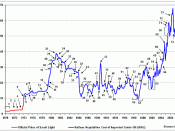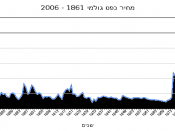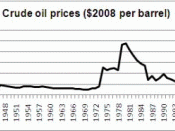Gasoline prices are influenced by a multitude of factors. Crude oil prices, the major component of gasoline, are higher. World oil supply is tight due to record growth in world oil demand. With gasoline demand at record levels, U.S. refineries have responded by producing record amounts of gasoline. Most refineries are running at a 96% utilization rate, far exceeding the general industry average of about 82% (Hackworth & Shore, 2004). There has been no net increase in U.S. refining capacity for the past three years, and the last new U.S. refinery was built in 1976 (Parker, 2004). Currently, there are 149 U.S. refineries, a roughly 50 percent decrease from 1980 of more than 300 refineries (Parker, 2004). It is increasingly difficult to build new facilities to increase production due to economic, environmental and political considerations, environmental requirements, rates of return on investment, and the social opposition factor. The biggest factors of all are supply and demand.
This paper examines an article on how refineries have impacted the economic reasoning behind the change in supply, demand, and price of gasoline.
Insufficient Supply
The Law of Supply states that the quantity supplied rises as price rises and the quantity supplied falls as price falls. When the price of a good rises, inividuals and firms can rearrange their activities in order to supply more of that good to the market (Colander, 2004). Unfortunately, this is not always the case since there might not be room for more supply.
"With the United States consuming record amounts of gasoline, there's never been a more dire need to build new oil refineries," (Parker, 2004, p. 2). Nonetheless, refinery closures have occurred every year over the past two decades. Domestically, the U.S. refineries are producing at capacity and have no more room for an increase in...


